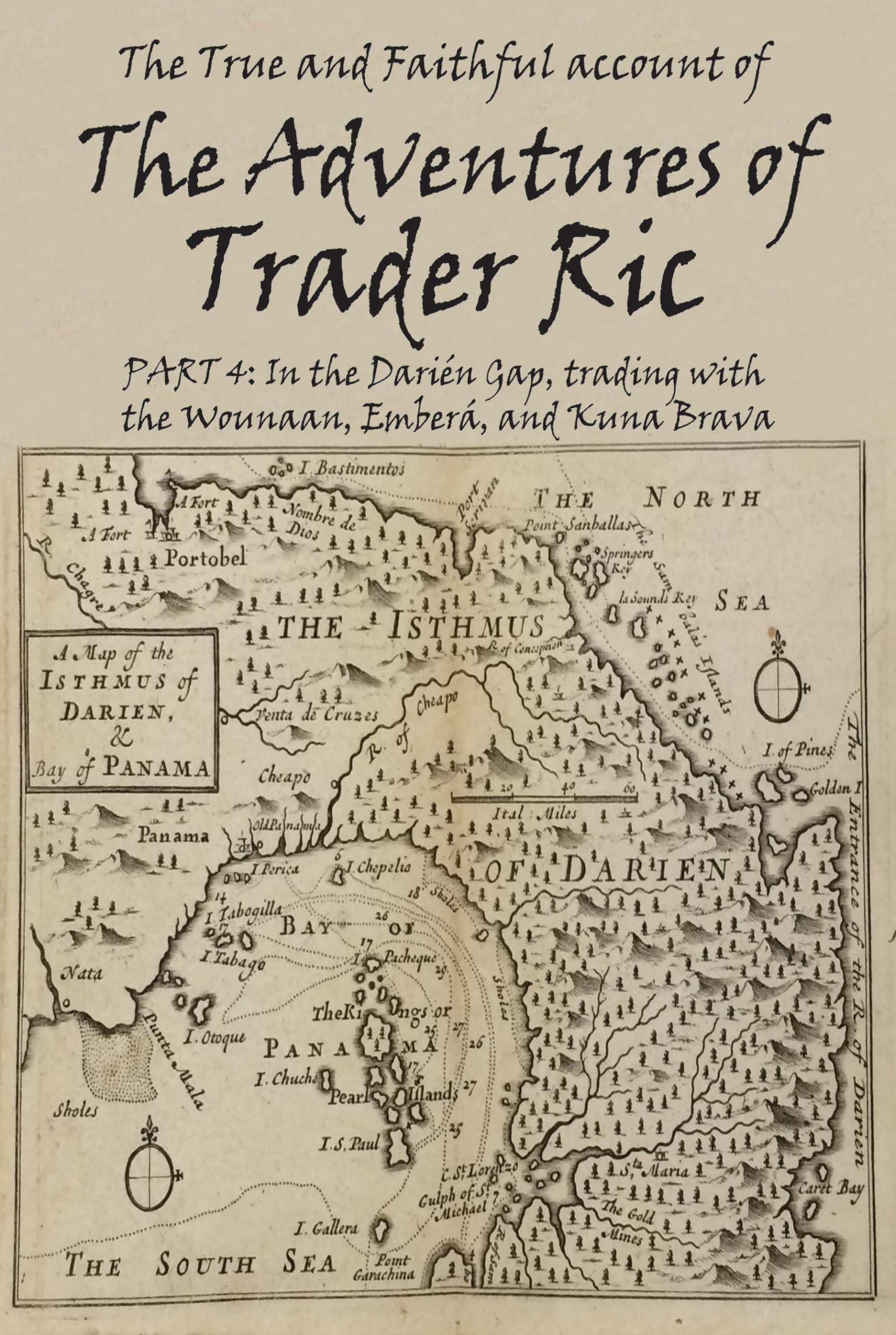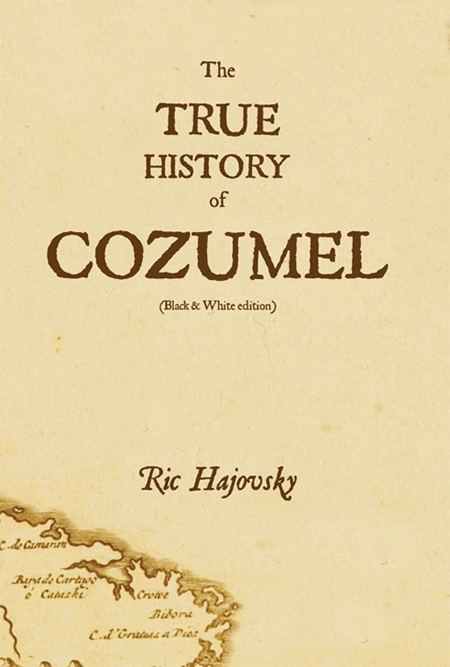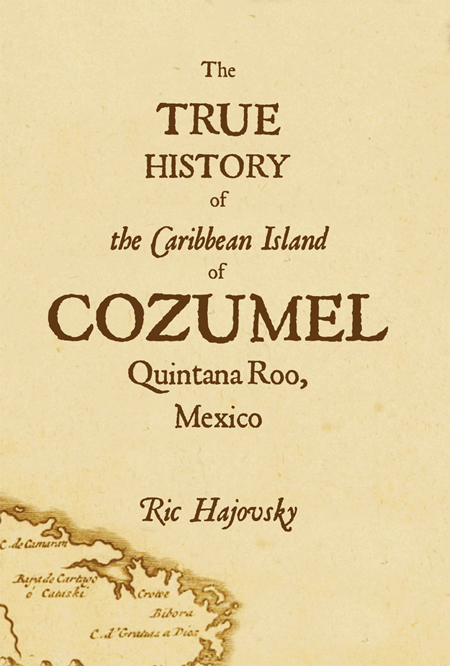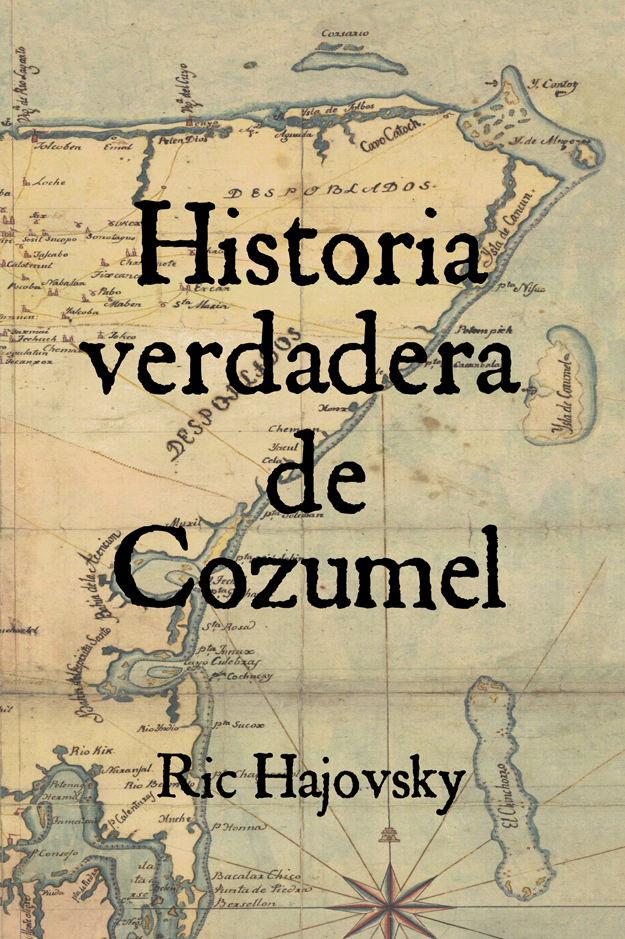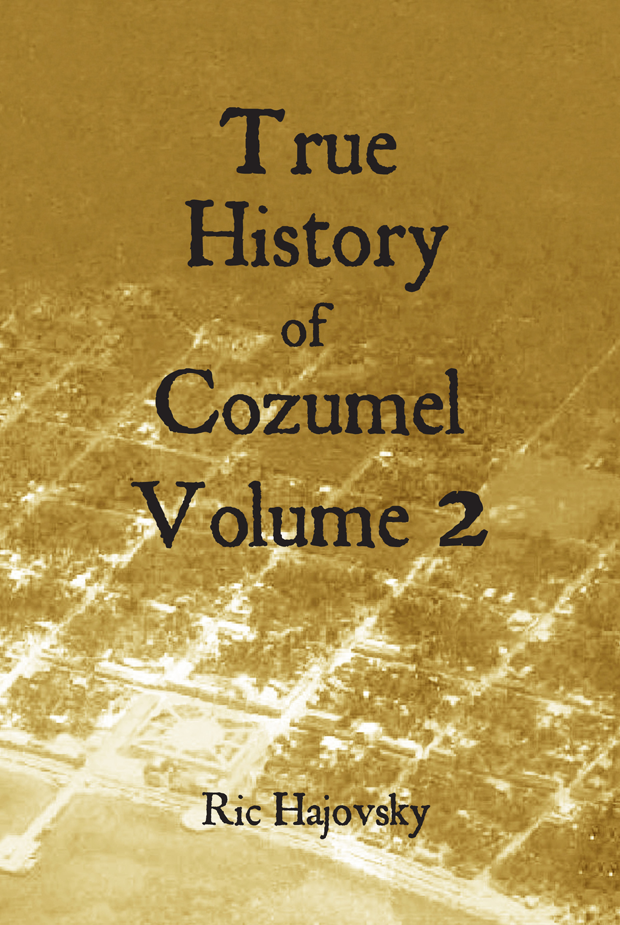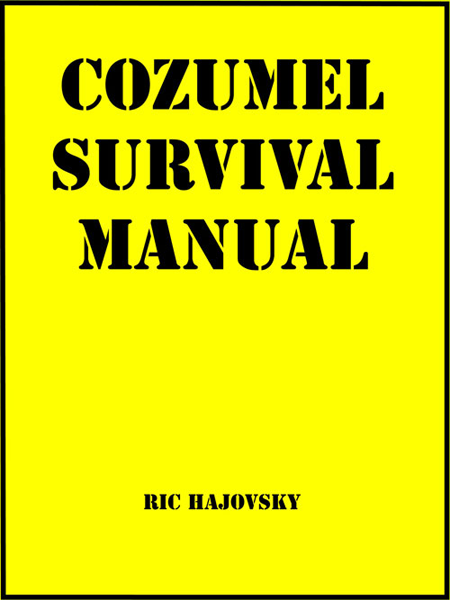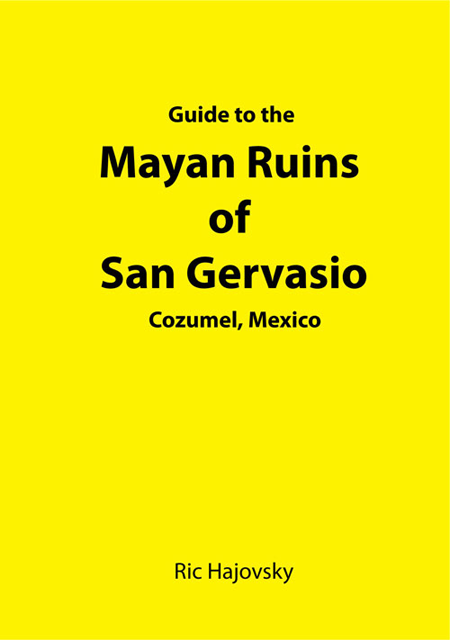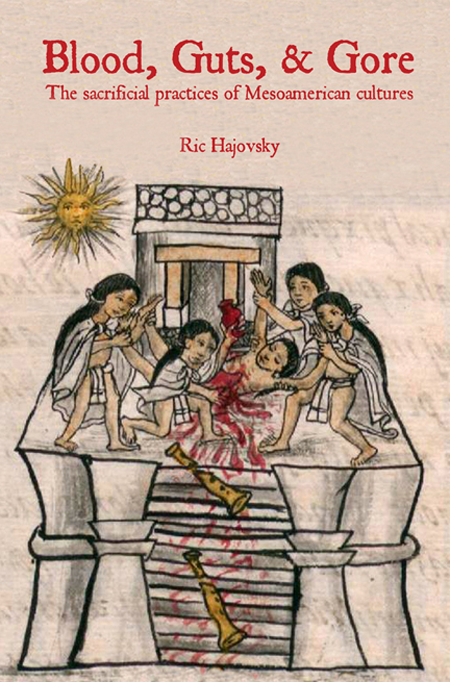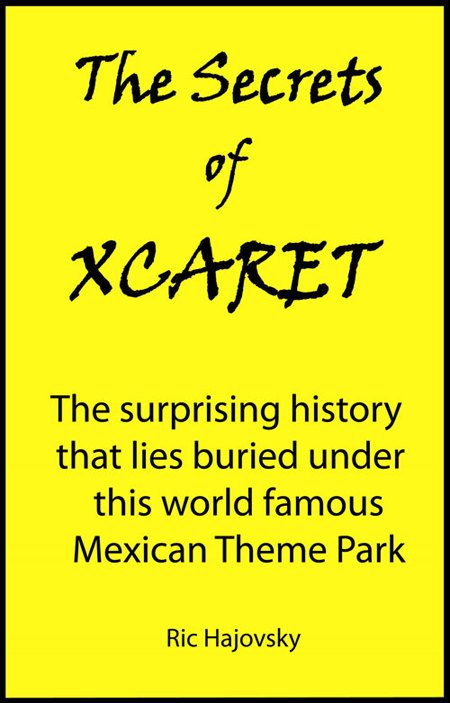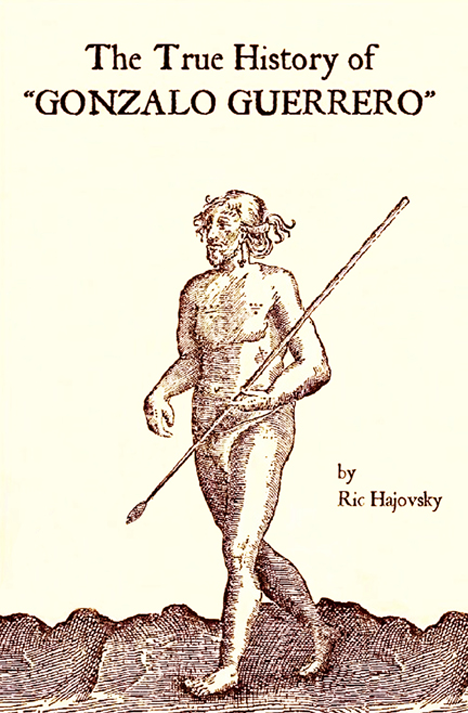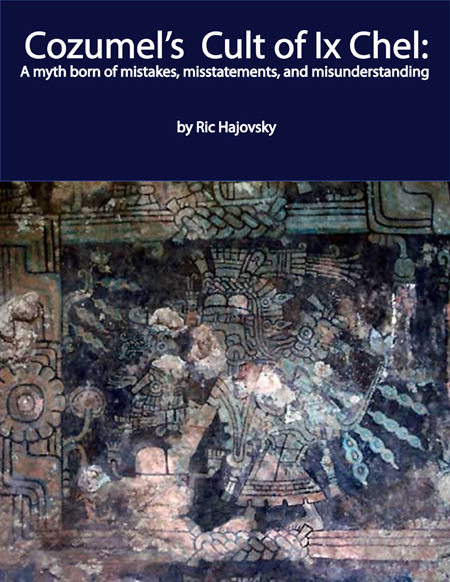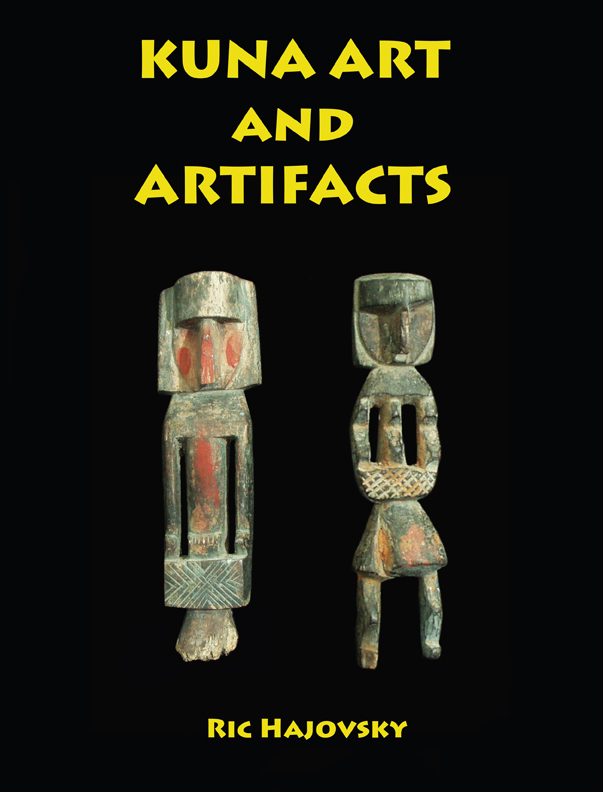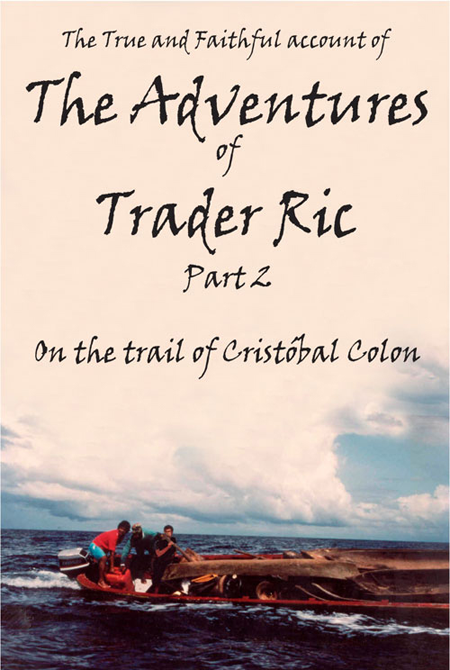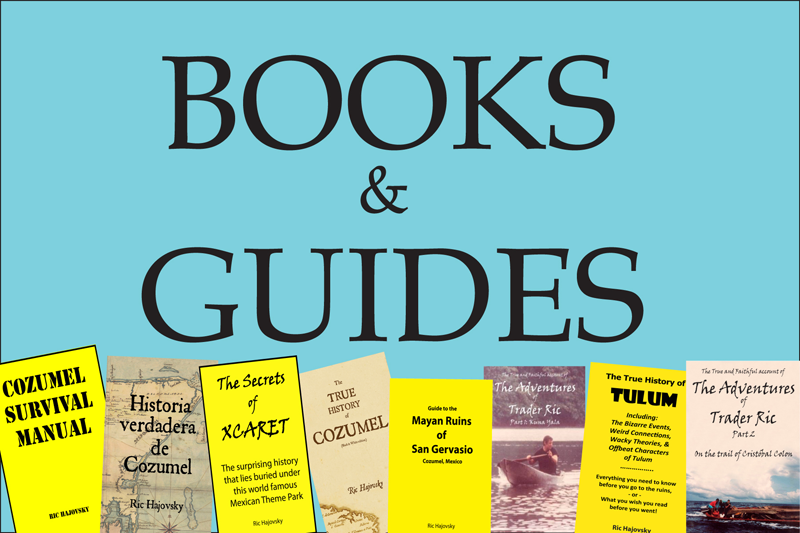
The True History of Cozumel (volume 1 and 2) is an impeccably researched, iconoclastic account of the island’s past that offers the reader accurate, detailed information that often disproves the dross masquerading as history found in tourist guide books, websites, and the like. By combing governmental archives, privately-held rare documents, and university microfilm collections, Hajovsky is able to explain through the presentation of first-hand accounts just how interesting Cozumel’s history turns out to be. Chapters in the book run the gamut from: Pirates’ testimony obtained through torture in the cells of the Holy Inquisition; The near annexation of Cozumel by the Republic of Texas in 1837; The role of Commodore Matthew Calbraith Perry in the resettlement of the island in 1848; Abraham Lincoln’s attempt to buy Cozumel and use it as a colony to house freed, black slaves; The original “Indiana Jones” and his search for German spies on the island in WWI; General López de Santa Ana’s role in developing the chewing gum fad that brought the island riches; To talking crosses, one-armed Christ statues, parrot-eating boas, and cannibalistic islanders.
Volume 1 black and white edition available from Amazon Books, here.
Volume 1 color edition available from Amazon Books, here.
Spanish edition of volume 1 available from Amazon Books, here
Volume 2 available from Amazon Books, here.
Para recibir libros de pasta suave en Mexico, clickea AQUI.
……………………………………….
COZUMEL’S GOLDEN YEARS is available as a color softbound edition, B&W softbound edition, or eBook. The softbound editions are 400 pages, 10 inches x 8 inches, with over 300 images and descriptions of Cozumel’s “good old days” from the 1950s to the 1990s. If you ever spent time on Cozumel, you will love this book. Loaded with memories!

……………………………
The Natural History of Cozumel, presents the myths, the facts, and the curious secrets of the island. Ric Hajovsky guides the reader through the birth of the island200 million years ago, the forces that created its unique landscape, Cozumel’s odd inhabitants (both plant and animal), and the strange phenomena that can be experienced on the island. A must read for anyone visiting or living on the island.
Natural History of Cozumel available from Amazon Books, here. Para recibirlo en Mexico, cliquea AQUI.
Thinking about moving to Cozumel? Already live here, but are having problems figuring out the system? Either way, the COZUMEL SURVIVAL MANUAL is what you need.
Our island has been attracting Americans ever since 1837 when the Navy of the Republic of Texas raised its flag over the little village of San Miguel in Texas’ first attempt to annex the island. From the early colonizing schemes attempted by folks like George Fisher (1841), Texan President Sam Houston (1842), American President Abraham Lincoln (1862) and land promoters like American Claude Goodyear (1874), all the way through to today’s time-share and condominium ownership plans, Americans have flocked to Cozumel in their search for a new life in paradise.
The islanders have always welcomed newcomers and go out of their way to make allowances for people who do not understand Cozumel’s laws and customs, but to really get the best out of living here you must try to learn the rules, if not the language.
This book is designed to help you learn what you need to know to live happily on our island and avoid many of the common pitfalls that seem to trip-up many new arrivals.
COZUMEL SURVIVAL MANUAL available from Amazon Books, here.
Your Content Goes Here
…………………………………….
GUIDE TO THE MAYAN RUINS OF SAN GERVASIO, COZUMEL
The archaeological site of San Gervasio is situated near the center of Cozumel and can be accessed by a paved road that turns north off the Carretera Transversal (the east-west road that leads to the eastern side of the island). The ruins are jointly administered by the Mexican institute of anthropology and history (INAH) and the foundation for parks and museums of Cozumel (FPMC), both of which charge a $4 USD entrance fee at two different ticket booths. The fee collected by INAH covers the maintenance of the ruins and the fee collected by FPMC takes care of the parking, tourist facilities, and road maintenance. The “tour guides” that are available for hire ($20 USD plus tip) at the site are not employees of either INAH or FPMC, but rather independent contractors who may (or may not) have a good grasp of the history of the site, depending on which one you get. If you go with an organized tour group, remember the tour guides prepared talk is geared to the lowest common denominator. Many people leave these tours asking themselves “what did I just see?”
If you are really interested in knowing about the background of San Gervasio, understanding the remains of the buildings and structures there and seeing how the Mayan civilization was structured, you definitely need to get a copy of The Yellow Guide to the Mayan Ruins of San Gervasio. It is the only guide book available of San Gervasio and was written by a former INAH project co-director who has lived on the island for many years.
Guide to the Ruins of San Gervasio available on Amazon Books, here. Para recibirlo en Mexico, cliquea AQUI.
…………………………………….
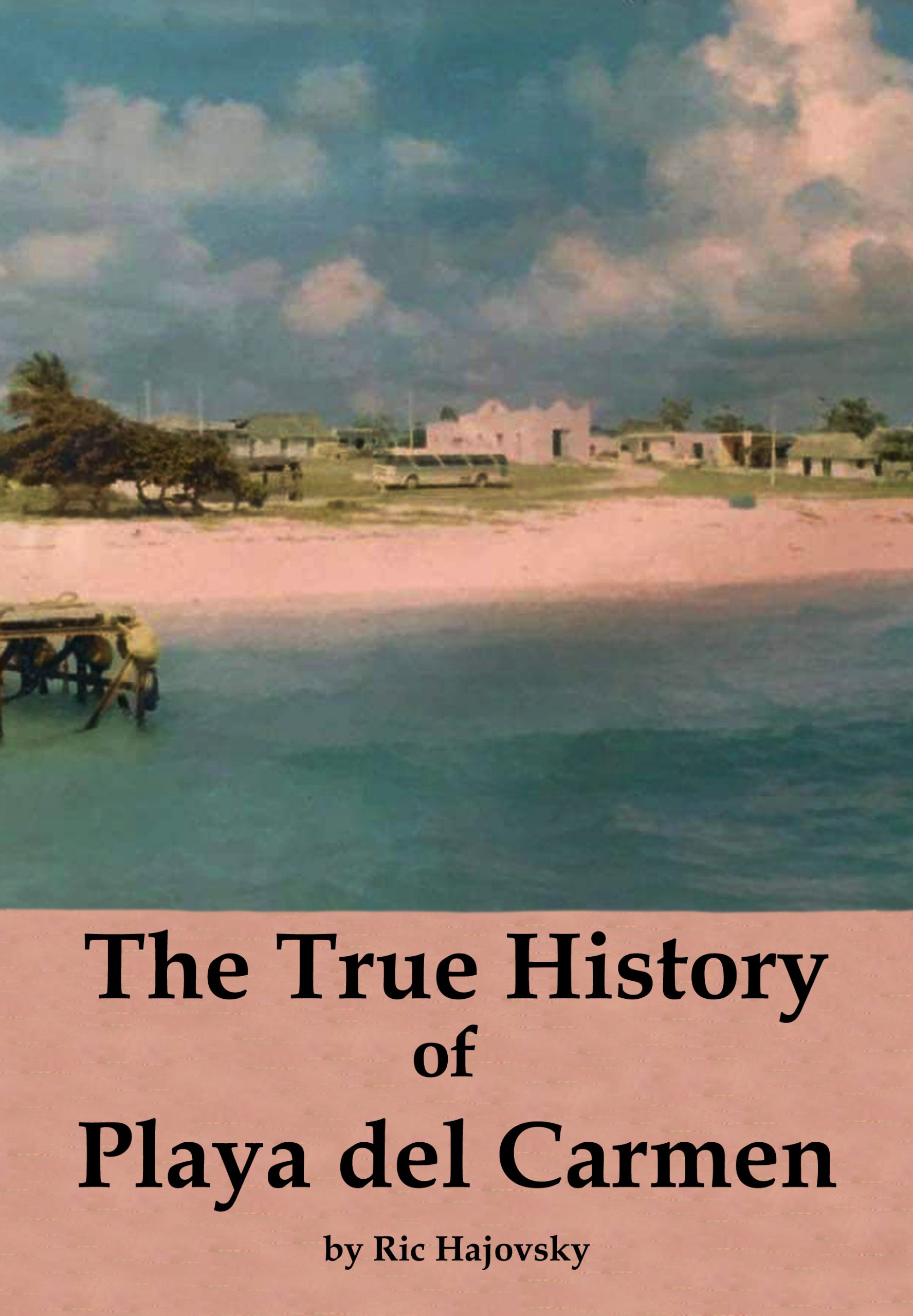
The True History of Playa del Carmen
Playa del Carmen is a whole lot more than beaches, shopping, bars, restaurants, and hotels. It is a place with a deep history, hidden now under all the glitz. This book will let you in on its secrets, from the age of the dinosaurs, through the time of the Maya empire, the Spanish conquest, and the reshaping of Playa from a chicle camp to the mega-resort it is today. From the same author as The True History of Cozumel, The True History of Tulum, The Secrets of Xcaret, Chichén Itzá (If we build it, they will come), and other well-researched, non-fiction books about Yucatan and Quintana Roo.
Available on Amazon books here:
…………………………………….

The True History of Cancun
This book will take you through Cancun’s history from the age of the dinosaurs up to the creation of the tourist destination we know today. Read the TRUE history of the Maya, the Spanish conquistadores, pirates, colonists, and others who lived in and around Cancun. This is not a rehashing of old myths and fables that you get from tour guides; this is an extremely well-researched work that tells you the true story of Cancun.
Available on Amazon books here
…………………………………..
Chichén Itzá: If we build it, they will come.
The story of the rebuilding of the site in the 1920s.
If you are going to Chichén Itzá to see “well preserved,” “pristine,” or “original” Maya buildings, let me be the first to burst your bubble. Today, archaeologists emphasize the stabilization and preservation of ancient ruins. In the 1920s and 1930s, when most of the work was done to the buildings you will see on your visit, the focus was on enhancing the beauty of the buildings to “wow” the tourist. No kidding. That was the idea. In their minds, rebuilding a pyramid or temple with newly cut stone in a likeness that was something drawn up by committee and that may, or may not, even come close to resembling the original was the order of the day. This book shows that process with many early images of the site, both before and after reconstruction.
Chichén Itzá: If we build it, they will come available at Amazon Books, here. Para recibirlo en Mexico, cliquea AQUI.
…………………………………
BLOOD, GUTS, AND GORE
An in-depth look into the sacrificial practices of the indigenous cultures of pre-Colombian Mexico. Profusely illustrated with images from pre-Colombia ceramics, bas-reliefs, and pre-contact and contact period codices, this book explains in detail the various methods the Aztec, Mixtec, Maya, Olmec, and other Mesoamerican groups went about dispatching their sacrificial victims. Flaying, immolation, disembowelment, drowning, heart extraction, garroting, stoning, and other methods are shown in these many, rarely-seen illustrations that indigenous scribes and artists drew between the mid fifteenth- to the late sixteenth-centuries.
BLOOD, GUTS, AND GORE available from Amazon Books, here. Para recibirlo en Mexico, cliquea AQUI.
………………………….
THE TRUE HISTORY OF TULUM
If you are going to visit the Mayan ruins of Tulum in Quintana Roo, Mexico (or have already) you need to read this book. It is chock-full of fun, weird, odd, and wacky bits of the history of the place that you will not find anywhere else. Also included are a short introduction to the history of the Tulum Maya, the early Spanish contacts with Tulum, the archaeology of the site, descriptions of the main buildings, and the stories of why and how they were built. In 1985, during a project carried out by the Instituto Nacional de Antropologia e Historia (INAH) and funded by a grant from the National Geographic Society, author Ric Hajovsky paddled a dug-out canoe over the reef to land on the beach at Tulum in an effort to test the theory that the Maya intended El Castillo to be used as a lighthouse. Later, he traveled the entire coast of Panama from the border of Costa Rica south to Colombia in Don Tiki, his 45-foot-long, ocean-going dugout which was similar to the type the Maya used to carry trade-goods from as far north as Tabasco to as far south as Honduras.
THE TRUE HISTORY OF TULUM available on Amazon Books, here. Para recibirlo en Mexico, cliquea AQUI.
…………………………
The Secrets of Xcaret is a non-fiction work that describes the surprising history that lies buried underneath this world-famous Mexican Theme Park. Beginning with the explanation of how the unusual geology of the region was formed millions of years ago, through the arrival of the first humans 40,000 years ago, the arrival and subsequent settlement of the area by the ancient Mayans, and the discovery and subsequent conquest of Xcaret by the Spaniards in the 16th century, the book describes all the past events that took place on the very spot that is now one of the most visited theme parks in Mexico.
The Secrets of Xcaret available on Amazon Books, here.
…………………………..
THE TRUE HISTORY OF “GONZALO GUERRERO”
This Kindle eBook can also be read on your laptop or desktop computer. It tells the true story of the Spaniard known today as Gonzalo Guerrero, who was shipwrecked on the coast of Quintana Roo, Mexico in 1511. The book begins with the description of the amazing trials and tribulations the man survived in Panama in 1510, prior to his shipwreck, as told by other survivors of that expedition. The book also presents an in-depth examination of the early historical documents that tell about the shipwreck and the events afterward, which are often at odds with the myth of Gonzalo Guerrero with which most people are familiar. A careful examination of the several fake manuscripts that are purported to have been written by Guerrero is also included, as is a new interpretation of exactly where the man was living up to the point he was said to have traveled to Honduras, where he was reported to have died in battle. The book also examines newly discovered details surrounding that battle and the lives of the survivors who reported the death of the Spaniard, as well as his real name. This is an exciting read of adventure, mystery, historical sleuthing, and myth-busting revelations.
THE TRUE HISTORY OF “GONZALO GUERRERO” available on Amazon Books, here.
Spanish edition available here.
…………………………..
COZUMEL’S CULT OF IX CHEL
A myth born of misstatements, mistakes, and misunderstandings
Twentieth-century, English-speaking researchers used translated primary ethnohistorical accounts or poorly paraphrased secondary sources as supporting evidence of a Cult of Ix Chel on Cozumel Island. Later investigators relied on the work of these earlier researchers without questioning their validity and repeated the theories contained in them as facts. A comparison of the original Spanish primary accounts against the theoretical models based on bad translations or paraphrased versions shows that the primary accounts do not support these theoretical models. These published theoretical models and the misleading statements they contain helped create a false history that leads researchers astray. There is an urgent need for a reexamination of the commonly held and widely published beliefs regarding a Cult of Ix Chel on Cozumel. This eBook offers a fresh look at the original texts and points out later writers’ mistakes in interpretation, erroneous statements, and fabricated details that led to the myth of Ix Chel and its unfortunate ramifications that we are dealing with today.
COZUMEL’S CULT OF IX CHEL available on Amazon Books, here.
……………………………
KUNA ARTS AND ARTIFACTS
Ric Hajovsky and his assistants motored his 45-foot dugout canoe (the Don Tiki) to every mainland and offshore Kuna village in the San Blas Comarca many times during the years he was collecting ethnographic material to sell to museums and collectors around the world. During those trips, he amassed not only a huge number of rare and seldom-seen artifacts, but also an education on how the Kuna used these pieces in their ceremonies and everyday life. This book contains over 47 black & white historical photos plus 980 color photographs of over 1,675 other artifacts of the thousands he acquired. Each type of artifact shown has a description of its manufacture, use, and the mythical beliefs connected to it. If you are a collector of Kuna material and bought parts of your collection in the US or Europe, you just might find some of your pieces illustrated in this compendium. This is a serious reference book that all collectors of Kuna ethnographic art should have in their library.
KUNA ARTS AND ARTIFACTS available on Amazon here.
………………………………
THE LOST KIVAS OF SAN LAZARO
Ric Hajovsky’s description of Forrest Fenn’s discovery and excavation of two underground ceremonial chambers in the Tano Indian ruin of San Lazaro in the Galisteo Basin of New Mexico.
THE LOST KIVAS OF SAN LAZARO available on Amazon Books, here.

…………………………..
The True and Faithful Account of the Adventures of Trader Ric, Part 1: In Kuna Yala
As an ethnographic art collector and dealer, Ric spent much of his time traveling in remote areas of South America gathering material from indigenous riverine and coastal tribes, targeting mainly ceremonial pieces used in their religious and healing ceremonies to sell to museums and collectors around the world. This book, Part 1 of a series, recounts his experiences traveling throughout the San Blas archipelago of Panama in his 45-foot-long dugout canoe, Don Tiki, and the many adventures and mis-adventures he had there dealing with the Kuna Indians. Ric brings the everyday life of the Kuna alive with his account of his island-by-island, hut-by-hut, search for material, all the while evading pirates, vampire bats, cholera, and even an angry crowd of Indians bent on revenge.
Trader Ric, Part 1: In Kuna Yala available on Amazon Books, here.
………………………………
The True and Faithful Account of the Adventures of Trader Ric, Part 2: On the trail of Cristobal Colon
The non-fiction Trader Ric series continues with this accounting of Ric’s adventures along the Veraguas coast of Panama, hunting for ethnological treasures among the Indian villages and coastal settlements while flashing back to his time working as an underwater archaeologist on the hunt for one of the ships Christopher Columbus lost during his disastrous 1502 voyage. The well-researched historical background of the chronicle sheds a new light on these little known expeditions as it describes the terrible hardships and misadventures the early Spanish explorers suffered as they tried in vain to discover the source of the Veraguas gold. Accompanied by his friend Hermiglio, the young fellow from Rio Belen, Ric survives the attempted coup d’etat of Manuel Noriega, an almost fatal capsizing of his 45-foot-long, sea-going dugout canoe in a storm one night while miles off-shore, and nearly being eaten by hungry bull sharks while diving in the turgid water of Rio Belen bay.
Trader Ric, Part 2: On the trail of Cristobal Colon available on Amazon Books, here.
……………………………..
The True and Faithful Account of the Adventures of Trader Ric, Part 3: Towards the headwaters of the Tapanahonie River, Suriname
The third volume in the non-fiction series of The Adventures of Trader Ric, this account relates his experiences and encounters as he travels by dugout canoe deep into the interior of Suriname, up to the headwaters of the Tapanahonie River. His mission on this expedition is to find, acquire, and bring back safely as much Tembe Sani he could get his hands on. Helped along the way by Herve (an Ex-French Legionaire gone native), Jean Tout (a semi-retired, SLA Ndjuka freedom fighter), Piku and Babu (the young cook and his pet howler monkey), Ric intertwines the narrative of the expedition with the history of the Maroon Societies (or Bosch Neggers) who still rule the region. The long trip upriver is punctuated by various obstacles: Lt. Col. Dési Bouterse’s renegade troops bent on extracting revenge on the Ndjukas, vampire bats, bullet ants, waterfalls, and a saliva-slathered fight with a guy who would soon be dead from rabies. All these and more have to be overcome before Ric reaches the Land of the Ndjuka, where his ethnographic treasures lie.
Part 3: Towards the headwaters of the Tapanahonie River available from Amazon Books, here.
**************************************
The True and Faithful Account of the Adventures of Trader Ric, Part 4: In the Darién Gap; Trading with the Emberá, Wounaan, and Kunas Bravas
This Part 4 is an account of Ric’s travels in the Darién villages and caserios (small Wounaan and Emberá family compounds) along the riverbanks of the Chuqunaque, Tuíra, Tupisa, Tuquesa, Chico, Capetí, Paya, Púcuro, Cupe, and Balsas Rivers. Over the years, he visited every Kuna, Emberá, Wounaan, and “Colono” village in Darien several times and many of the caserios.
Things have changed greatly in Panama and its Darién Province since he was working there over 40 years ago. The tiny villages he visited back then only had a few thatched-roofed huts sprinkled around. No electricity, water wells, or cement buildings with zinc roofs, let alone internet and cell phone coverage. Places like Lajas Blancas, once a sleepy group of huts, are now bustling refugee centers and the seat of the Emberá comarca’s government. The village (indeed, the entire area) is now overrun by thousands of people from Haiti, Venezuela, Cuba, Africa, and beyond, all making their way north to the US border. The Colombian revolutionary guerillas (FARC) have settled down some, but killings and kidnappings have become even more commonplace than when he was there. US Army no longer has priority over the small landing strips in the province and their presence has been replaced by Senafront (the Panamanian border police) and forest rangers. Neither group does much to control the area.
The selva (jungle) is now divided into national parks and reserves, but it is still a nearly impenetrable and inhospitable place. Rivers have changed course, the Pan-American “highway” got paved in asphalt all the way to Yaviza, and some villages he visited have disappeared while others have sprung up in places there never was one. The riverbanks are now clogged with garbage and refuge the migrants throw away and the river water is polluted with rotting bodies and tons of human waste.
The Wounaan and the Emberá dress, rites, customs, and nearly all other aspects of their respective cultures have changed as well. Men rarely wear the loincloth, except for events they put on for tourists in the northernmost villages. Women wear bras or cover their breasts with non-traditional tops made from new coins and beads. Most villages no longer have a practicing shaman. Naming and coming-of-age ceremonies are very rarely held anymore. Young indigenous men often work as “coyotes,” herding immigrants from the Colombian border to refugee camps in Panama. Others act as drug mules. Many now have Facebook accounts and email addresses. “The times, they are a-changin’.”
Reading Part 4 of the Trader Ric series will give you an intimate view of the old lifestyle and customs of these rainforest cultures that have so drastically changed in the past couple of generations.
Part 4: In the Darién Gap; Trading with the Emberá, Wounaan, and Kunas Bravas is availabe by clicking HERE.
